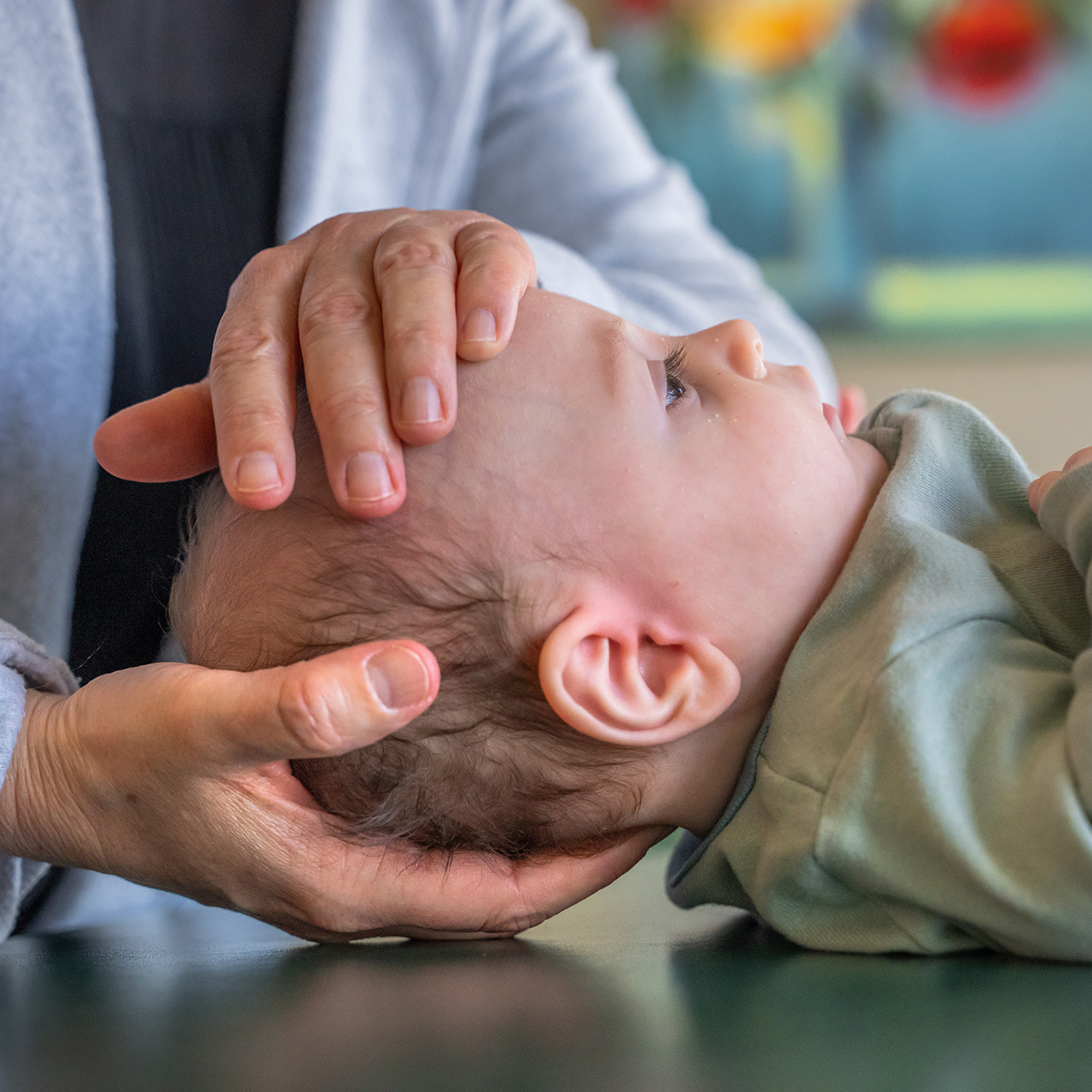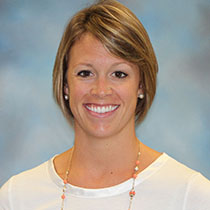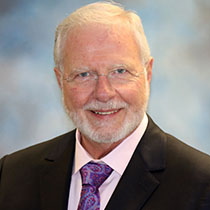
The Department of Osteopathic Manipulative Medicine (OMM) at the Michigan State University College of Osteopathic Medicine (MSUCOM) is busy with new clinical research studies and service offerings to help diagnose, treat and prevent a wide range of symptoms and conditions using osteopathic manipulative treatment (OMT). From concussions and low back pain in adults to head shape and feeding difficulties for babies, read on for what’s new with MSUCOM OMM.
Catherine Donhue, D.O., Department of Osteopathic Manipulative Medicine chair
OMT addresses baby’s head shape, feeding difficulties and fussiness with expert care
The MSU Health Care Osteopathic Manipulative Medicine clinic in East Lansing, Mich., has increased its capacity to provide in- and out-patient OMT services for mothers pre- and post-pregnancy, as well as their newborns.
“We wanted to expand services to help better serve the community,” explained Catherine Donahue, D.O., OMM chair at MSUCOM. “Earlier care allows us to address restrictions before they potentially become bigger issues. Birth trauma and pain, feeding difficulties and torticollis (tilted or twisted neck) are some examples that an OMM approach can help with.”
OMT can restore normal structure and function throughout the body, while also supporting the body’s natural, physiological processes. For women, pregnancy and the birthing process cause a wide range of physical changes, which OMT can help correct.
“Pregnant and postpartum women can benefit from OMT to restore normal sacral and pelvic alignment, to balance the autonomic nervous system and reduce spinal restrictions to allow the body to get into more beneficial positions to take care of baby and themselves,” Dr. Donahue said.
OMT can also be used to help infants feed by stimulating nerves at the back of the head and treating tight connective tissues. While it’s normal for parents to have heightened concerns for their newborns, Dr. Donahue said OMT is safe for babies and the pediatric population as a whole.
“OMT is gentle and well-tolerated – no adverse events have been reported,” she explained, noting that more clinical trials in the future can help further support OMT’s efficacy and safety. “Our D.O.s use gentle pressure to release restrictions in the tissues, muscles and bones. The pressure applied is barely enough to blanch a fingernail.”
Clarence Nicodemus, D.O., Ph.D., professor and director of the MSU Center for Neuromusculoskeletal Clinical Research
Low back pain is as common as the common cold
The vast majority of people – 85% – will experience low back pain at some point, or multiple points, in life. For veterans, chronic low back pain is a frequent complaint. But low back pain can be a complex symptom for providers and patients to manage because the cause is often unclear, meaning a treatment that works for one person may not work well for another.
To align with the U.S. Department of Veterans Affairs (V.A.) “Whole Health” approach, Clarence Nicodemus, D.O., Ph.D., and John Popovich, Ph.D., ATC, D.PT, were awarded a two-year, $330,000 grant from the U.S. Department of Defense to evaluate the feasibility of OMT as a cost-effective, non-pharmacological intervention for veterans with chronic low back pain.
“We’re trying to introduce the concept of OMT into the usual tools that M.D.s and other providers can use to treat chronic low back pain,” Dr. Nicodemus explained. “In V.A. hospitals across the country, the number of D.O.s is very limited compared to M.D.s, and of all osteopathic physicians that go out and practice, only 5% use OMT on a regular basis.”
At Edward Hines, Jr. V.A. Hospital in Chicago, veterans with chronic low back pain will receive either usual care or usual care with OMT added. At 12 and 24 weeks of treatment, the team will assess each group’s clinical outcomes for symptoms like pain severity, physical function, mental health, sleep quality and medication use.
“I’m a Vietnam veteran,” Dr. Nicodemus shared, “and I’m really pleased to be able to work with the V.A. in doing this research. OMT holds promise for faster recovery and reduced reliance on rescue pain medicines and opioids. Together, this would lead to overall fewer adverse outcomes.”
Using OMT to improve concussion care
Between athletics, motor vehicle accidents and other impact-driven events, concussions are common. Among athletes alone, the Centers for Disease Control and Prevention estimate approximately 3.8 million concussions are reported each year. (But many injuries go unreported, raising the potential for higher incidence rates.)
When they are reported, health care providers work with patients to manage and monitor their symptoms. But Jacek Cholewicki, Ph.D., professor in spinal biomechanics at the MSU Center for Neuromusculoskeletal Clinical Research, and Dr. Donahue are studying OMT as a potential update to standard concussion care that could help improve recovery.
“It’s giving people their quality of life back,” Dr. Donahue said. “There are people in our community that suffer from concussions, we have a large clinical practice, and we have a great research team. That's why we chose to do this work. We’re trying to help our community and beyond.”
Read more about MSUCOM’s OMT concussion study in this issue of SpartanDO Journeys magazine.
By E. LaClear
The Department of Osteopathic Manipulative Medicine (OMM) at the Michigan State University College of Osteopathic Medicine (MSUCOM) is busy with new clinical research studies and service offerings to help diagnose, treat and prevent a wide range of symptoms and conditions using osteopathic manipulative treatment (OMT). From concussions and low back pain in adults to head shape and feeding difficulties for babies, read on for what’s new with MSUCOM OMM.
Catherine Donhue, D.O., Department of Osteopathic Manipulative Medicine chair
OMT addresses baby’s head shape, feeding difficulties and fussiness with expert care
The MSU Health Care Osteopathic Manipulative Medicine clinic in East Lansing, Mich., has increased its capacity to provide in- and out-patient OMT services for mothers pre- and post-pregnancy, as well as their newborns.
“We wanted to expand services to help better serve the community,” explained Catherine Donahue, D.O., OMM chair at MSUCOM. “Earlier care allows us to address restrictions before they potentially become bigger issues. Birth trauma and pain, feeding difficulties and torticollis (tilted or twisted neck) are some examples that an OMM approach can help with.”
OMT can restore normal structure and function throughout the body, while also supporting the body’s natural, physiological processes. For women, pregnancy and the birthing process cause a wide range of physical changes, which OMT can help correct.
“Pregnant and postpartum women can benefit from OMT to restore normal sacral and pelvic alignment, to balance the autonomic nervous system and reduce spinal restrictions to allow the body to get into more beneficial positions to take care of baby and themselves,” Dr. Donahue said.
OMT can also be used to help infants feed by stimulating nerves at the back of the head and treating tight connective tissues. While it’s normal for parents to have heightened concerns for their newborns, Dr. Donahue said OMT is safe for babies and the pediatric population as a whole.
“OMT is gentle and well-tolerated – no adverse events have been reported,” she explained, noting that more clinical trials in the future can help further support OMT’s efficacy and safety. “Our D.O.s use gentle pressure to release restrictions in the tissues, muscles and bones. The pressure applied is barely enough to blanch a fingernail.”
Clarence Nicodemus, D.O., Ph.D., professor and director of the MSU Center for Neuromusculoskeletal Clinical Research
Low back pain is as common as the common cold
The vast majority of people – 85% – will experience low back pain at some point, or multiple points, in life. For veterans, chronic low back pain is a frequent complaint. But low back pain can be a complex symptom for providers and patients to manage because the cause is often unclear, meaning a treatment that works for one person may not work well for another.
To align with the U.S. Department of Veterans Affairs (V.A.) “Whole Health” approach, Clarence Nicodemus, D.O., Ph.D., and John Popovich, Ph.D., ATC, D.PT, were awarded a two-year, $330,000 grant from the U.S. Department of Defense to evaluate the feasibility of OMT as a cost-effective, non-pharmacological intervention for veterans with chronic low back pain.
“We’re trying to introduce the concept of OMT into the usual tools that M.D.s and other providers can use to treat chronic low back pain,” Dr. Nicodemus explained. “In V.A. hospitals across the country, the number of D.O.s is very limited compared to M.D.s, and of all osteopathic physicians that go out and practice, only 5% use OMT on a regular basis.”
At Edward Hines, Jr. V.A. Hospital in Chicago, veterans with chronic low back pain will receive either usual care or usual care with OMT added. At 12 and 24 weeks of treatment, the team will assess each group’s clinical outcomes for symptoms like pain severity, physical function, mental health, sleep quality and medication use.
“I’m a Vietnam veteran,” Dr. Nicodemus shared, “and I’m really pleased to be able to work with the V.A. in doing this research. OMT holds promise for faster recovery and reduced reliance on rescue pain medicines and opioids. Together, this would lead to overall fewer adverse outcomes.”
Using OMT to improve concussion care
Between athletics, motor vehicle accidents and other impact-driven events, concussions are common. Among athletes alone, the Centers for Disease Control and Prevention estimate approximately 3.8 million concussions are reported each year. (But many injuries go unreported, raising the potential for higher incidence rates.)
When they are reported, health care providers work with patients to manage and monitor their symptoms. But Jacek Cholewicki, Ph.D., professor in spinal biomechanics at the MSU Center for Neuromusculoskeletal Clinical Research, and Dr. Donahue are studying OMT as a potential update to standard concussion care that could help improve recovery.
“It’s giving people their quality of life back,” Dr. Donahue said. “There are people in our community that suffer from concussions, we have a large clinical practice, and we have a great research team. That's why we chose to do this work. We’re trying to help our community and beyond.”
Read more about MSUCOM’s OMT concussion study in this issue of SpartanDO Journeys magazine.
By E. LaClear


